Key takeaways:
- Community housing development focuses on creating inclusive and sustainable environments that foster connections among residents.
- Strong support networks enhance resilience, promote collaboration, and provide valuable resources for residents.
- Identifying and engaging key stakeholders can significantly amplify community development efforts and create impactful partnerships.
- Effective communication, knowledge sharing, and celebrating contributions are essential for sustaining and growing community networks.
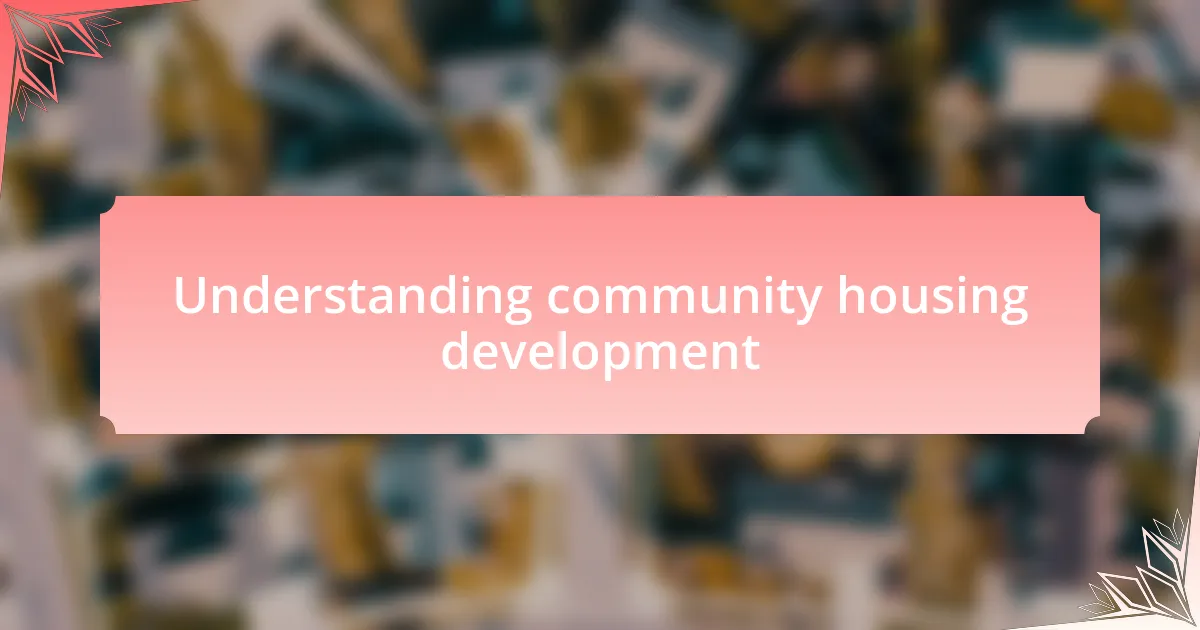
Understanding community housing development
Community housing development is more than just constructing buildings; it’s about creating spaces where individuals can thrive together. I remember visiting a community housing project where the atmosphere was filled with laughter and collaboration. It struck me then: how a thoughtful design can foster connections among residents. Can a building truly become a home if it doesn’t promote relationships?
At its core, community housing emphasizes inclusivity and sustainability. I’ve seen firsthand how projects that consider diverse needs—from families to seniors—can transform lives. For instance, a local initiative created gardens and shared spaces, which encouraged neighbors to interact and support one another. It raises an important question: how can we ensure that every voice is heard in a community housing project?
The success of community housing hinges on understanding and addressing the unique needs of its residents. When I spoke with a resident who benefited from supportive services like job training and childcare, their gratitude was palpable. They expressed how these services not only supported their family but also built a sense of belonging. Isn’t it fascinating how a holistic approach to community housing can uplift everyone involved?
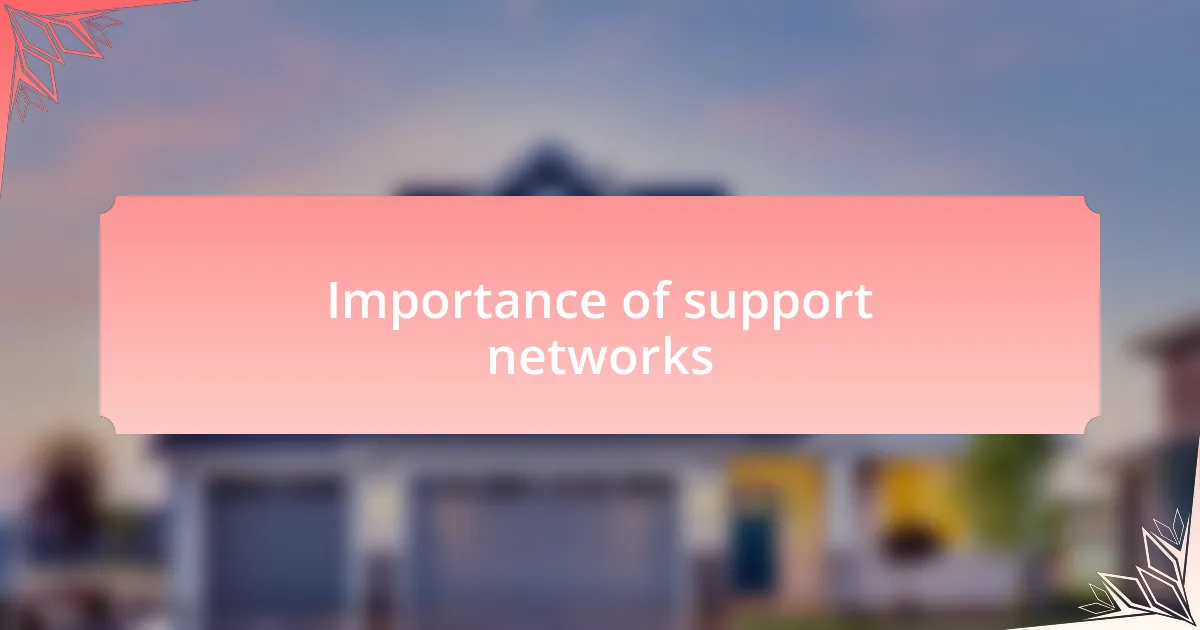
Importance of support networks
A strong support network can be a lifeline for individuals living in community housing. I vividly recall a resident sharing how her neighbors rallied around her during a difficult time, offering meals and emotional support. This experience underscored for me how crucial it is to nurture those bonds; they create a safety net that not only facilitates daily survival but also fosters a sense of belonging.
Moreover, support networks can significantly enhance the resources available to residents. I once organized a workshop where residents shared their skills, from cooking to financial planning. The excitement in the room was palpable, as people discovered they could learn from one another. Isn’t it incredible how sharing personal expertise can strengthen community ties while empowering individuals?
Ultimately, the importance of support networks goes beyond simply providing assistance; they promote resilience and hope. Reflecting on my experiences, I have come to appreciate that when people connect and collaborate, they build not only homes but vibrant communities. Can you imagine the collective strength of a well-knit network during challenging times?
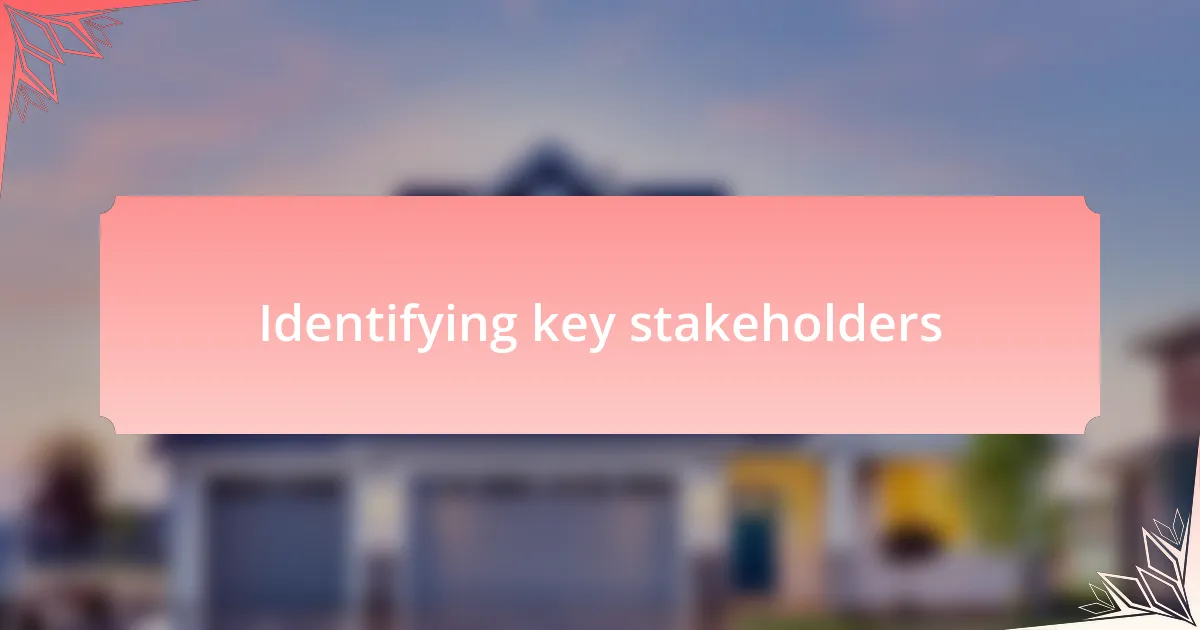
Identifying key stakeholders
Identifying key stakeholders is a critical first step in building an effective support network. During my early days in community housing initiatives, I learned that stakeholders can include residents, local businesses, non-profits, and even government entities. Recognizing who these players are doesn’t just help in building connections; it also lays the groundwork for potential collaborations that can amplify resources and support for everyone involved.
In one instance, while developing a community garden, I reached out to local garden supply stores. To my surprise, many were eager to contribute materials or expertise, turning what might have been a modest initiative into a vibrant project that included workshops and a weekly farmers’ market. Isn’t it fascinating how simply identifying and engaging with the right stakeholders can lead to impactful community development?
Moreover, I’ve found that understanding the motivations of each stakeholder can turn relationships into genuine partnerships. For instance, collaborating with local schools helped not only increase volunteer involvement but also enriched the educational experiences of students. Have you ever noticed how the synergy between different groups can create unexpected opportunities? It’s moments like these that remind me of the power that comes from building a diverse and engaged network.
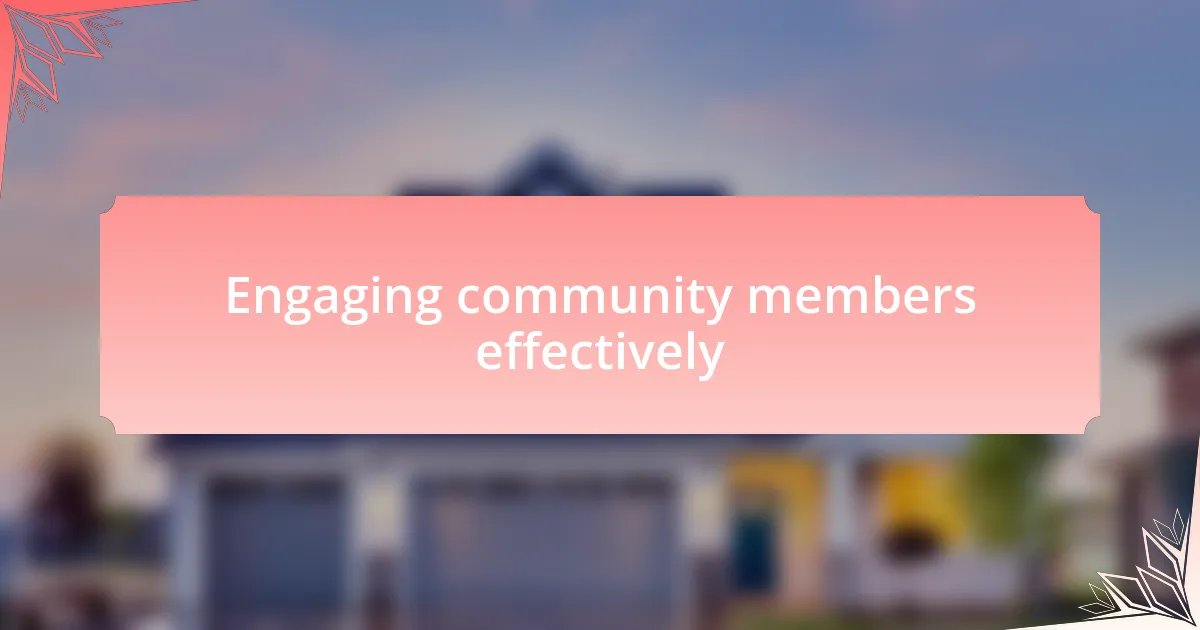
Engaging community members effectively
Engaging community members effectively starts with creating an inclusive atmosphere where everyone feels valued. I vividly remember hosting a community meeting for a new housing project where I made a point to encourage everyone to share their thoughts. The excitement in the room as people exchanged ideas was palpable, and I realized then how vital it is to foster an environment where voices can be heard. Have you experienced such a moment, where the collective wisdom of a group truly shines through?
Another key aspect of engagement is utilizing various communication channels. I once organized a monthly newsletter to keep everyone informed about project updates and community events. Surprisingly, combining traditional paper newsletters with digital platforms allowed us to reach a broader audience. I often wonder, how can we adapt our communication to ensure that no one is left behind in the conversation?
Listening to community feedback is crucial too. I recall a time when residents expressed concerns about design aspects in a proposed housing project. Instead of dismissing their input, I took the opportunity to organize a design workshop. This not only addressed their concerns but also allowed community members to feel invested in the process. It’s moments like these that turn potential conflict into collaboration, don’t you think?
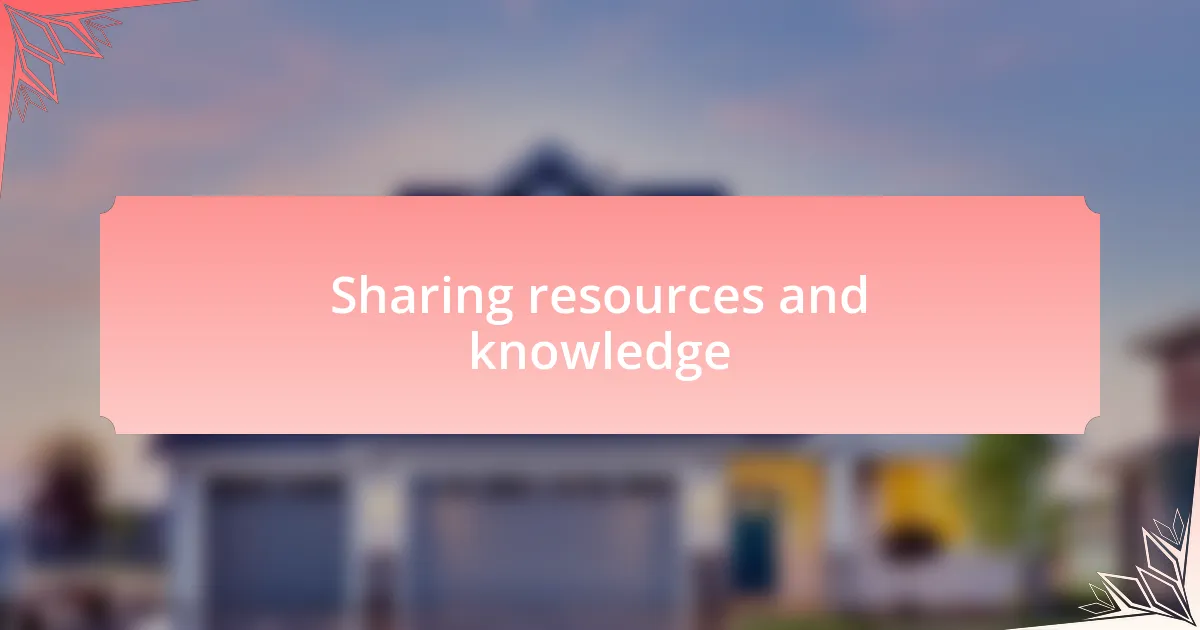
Sharing resources and knowledge
Sharing resources and knowledge effectively can transform a community housing project. I remember a local initiative where we set up a resource library filled with everything from construction manuals to local contractors’ contacts. It not only empowered residents with valuable information but also fostered a sense of trust and collaboration that was truly heartwarming.
One time, I facilitated a workshop where community members shared their experiences and skills related to home maintenance. Seeing individuals swap tips and insights about everything from plumbing to gardening was inspiring. How often do we realize that knowledge sharing can build relationships as strong as bricks and mortar?
The importance of online platforms cannot be overstated in this digital age. I created a Facebook group specifically for our housing community, and it became a hub for sharing resources and organizing events. When someone needed help with a repair or was seeking advice on local services, the collective wisdom of the group was just a post away. Isn’t it amazing how technology can bridge gaps and create a sense of belonging?
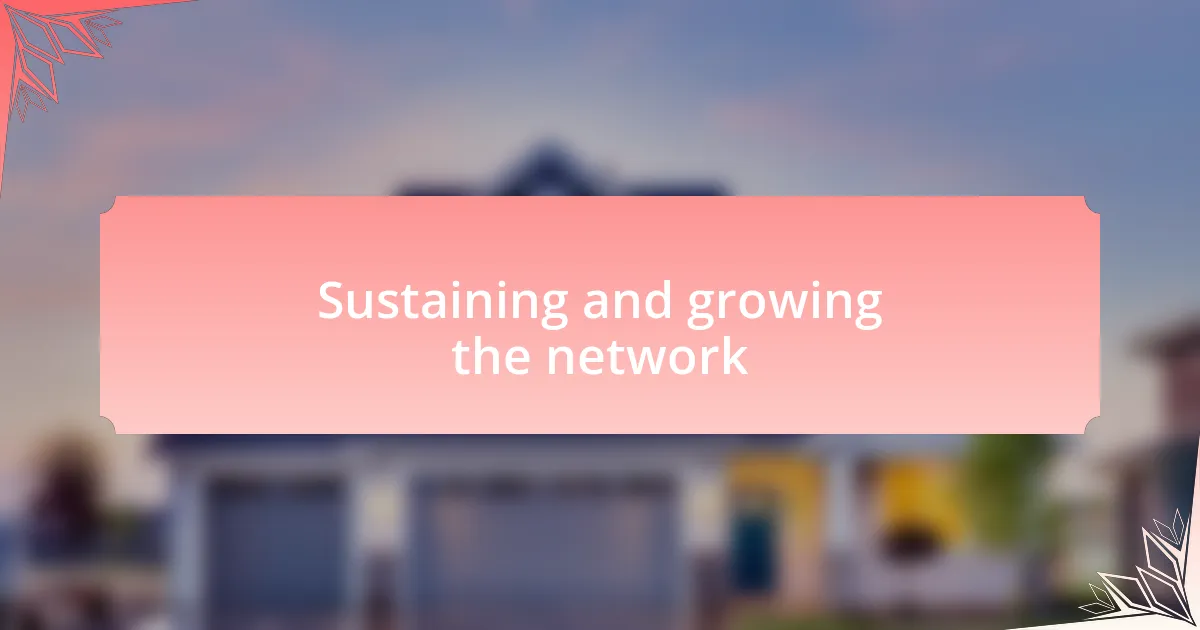
Sustaining and growing the network
To sustain and grow a support network, consistent communication is key. I make it a point to regularly check in with network members through monthly meetings and informal coffee catch-ups. The richness of these interactions often reveals hidden talents and resources that can bolster our collective efforts—have you ever found inspiration in unexpected places?
I also believe in celebrating milestones, no matter how small. Last year, we organized a community potluck to honor everyone’s contributions to our projects. It was uplifting to see the joy on people’s faces as they connected over shared meals and stories. This simple act not only strengthened our bonds but also reinforced the importance of acknowledging each person’s unique role in our community.
As we look to the future, it’s crucial to invite new members into the fold. I actively reach out to newcomers, encouraging them to share their insights and needs. Their fresh perspectives not only bring in new energy but also help us adapt and thrive as a dynamic community. Have you thought about how inclusivity can power growth in your own networks?